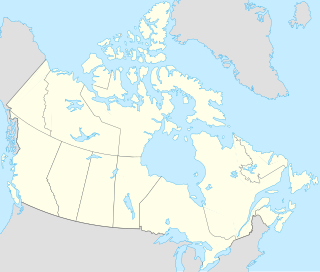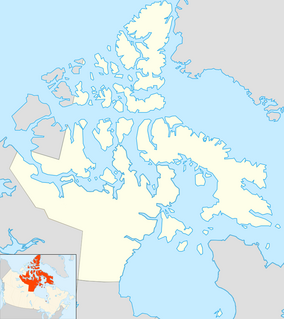
Alexander Island is one of the Canadian arctic islands located in Nunavut, Canada. It lies south of Massey Island and Île Marc, and north of Bathurst Island. Located at 75°52'N 102°37'W it has an area of 484 km2 (187 sq mi), 42.8 kilometres (26.6 mi) long and 19 kilometres (12 mi) wide.

Adams Island is an uninhabited island in the Qikiqtaaluk Region of Nunavut, Canada. The island is located in Baffin Bay off the northeastern coast of Baffin Island in the Canadian Arctic Archipelago. Nearby are Dexterity Island (northeast), Dexterity Fiord and Baffin Island (east), Tromso Fiord (south), Paterson Inlet (west), Bergesen Island (northwest), and Isbjorn Strait (north).
The Peter Richards Islands are members of the Canadian Arctic Archipelago in the territory of Nunavut. They are located in Baffin Island's Admiralty Inlet.

Davids Island is a member of the Canadian Arctic Archipelago in the Qikiqtaaluk Region, Nunavut. It is an irregularly shaped Baffin Island offshore island, located in Admiralty Inlet, at the mouth of Fleming Inlet and Fabricius Fiord.

The uninhabited Saneruarsuk Islands are members of the Canadian Arctic Archipelago in the territory of Nunavut. They are irregularly shaped, Baffin Island offshore islands, located in the Admiralty Inlet. Yeoman Island lies to their northwest.
Yeoman Island is an uninhabited member of the Canadian Arctic Archipelago in the territory of Nunavut. Located in Admiralty Inlet, it is an irregularly shaped Baffin Island offshore island. The Saneruarsuk Islands lie to its southeast.
Stephens Island is a member of the Canadian Arctic Archipelago in the territory of Nunavut. Located in Milne Inlet just north of Koluktoo Bay, it is an irregularly shaped island off the Baffin Island coast.

One of the Baffin Island offshore, uninhabited island groups, the Kaigosuiyat Islands are located between Irvine Inlet and Nettilling Fiord, south of Iglunga and southwest of Pangnirtung. They are part of the Qikiqtaaluk Region, in the Canadian territory of Nunavut.

One of the uninhabited Baffin Island offshore island groups in Cumberland Sound, the Kaigosuit Islands are located long the south side of Nettilling Fiord, and southwest of Pangnirtung. The Kaigosuiyat Islands run parallel to the south. Further south is Irvine Inlet. The Kaigosuits are part of the Qikiqtaaluk Region, in the Canadian territory of Nunavut.

The Wollaston Islands are uninhabited members of the Canadian Arctic Archipelago in the territory of Nunavut. Located on the east side of the mouth of Navy Board Inlet, the island group is closer to Bylot Island than to Baffin Island.

Aupaluktut Island is an uninhabited Baffin Island offshore island located in the Canadian Arctic Archipelago in Nunavut's Qikiqtaaluk Region. It lies in Cumberland Sound, between Brown Inlet and Ikpit Bay. It rises approximately 30 m (98 ft) above sea level. Nuvujen Island lies to its north. Robert Peel Inlet is due south, approximately 29.4 km (18.3 mi) away.
Opingivik Island is an uninhabited Baffin Island offshore island located in the Canadian Arctic Archipelago in Nunavut's Qikiqtaaluk Region. It lies in Cumberland Sound between Ikpit Bay to the north and Robert Peel Inlet approximately 18.6 km (11.6 mi) to the south.
Maktaktujanak Island is an uninhabited Baffin Island offshore island located east of Shakshukuk Island in the Canadian Arctic Archipelago in Nunavut's Qikiqtaaluk Region. It lies in Cumberland Sound, approximately 15.4 km (9.6 mi) from Robert Peel Inlet
Shakshukowshee Island is a Baffin Island offshore island located in the Canadian Arctic Archipelago in Nunavut's Qikiqtaaluk Region. The uninhabited island lies in Cumberland Sound, at the mouth of Robert Peel Inlet. Shakshukuk Island lies along its east side.
Kangigutsak Island is an uninhabited Baffin Island offshore island located in the Canadian Arctic Archipelago in Nunavut's Qikiqtaaluk Region. It lies in Cumberland Sound, across the mouth of Robert Peel Inlet. Shakshukuk Island lies north.
Utsusivik Island is an uninhabited Baffin Island offshore island located in the Canadian Arctic Archipelago in Nunavut's Qikiqtaaluk Region. It lies in Cumberland Sound, across the mouth of Chidliak Bay, approximately 14.4 km (8.9 mi) southeast of Robert Peel Inlet Nimigen Island lies to its west.
The Eider Islands are an uninhabited Canadian Arctic islands group in the Qikiqtaaluk Region of Nunavut, Canada. The 172 small islands are located in western Ungava Bay off the northern coast of Quebec. The closest community is Quaqtaq, Quebec, 20 km (12 mi) to the northwest.
Round Island is an uninhabited island in the Qikiqtaaluk Region of Nunavut, Canada. It is located across the mouth of Coutts Inlet in Baffin Bay off the northeastern coast of Baffin Island. Nova Zembla Island is 7.4 km (4.6 mi) to the northwest.

Scott Island is an uninhabited island in the Qikiqtaaluk Region of Nunavut, Canada. It is located in Baffin Bay, off the eastern coast of Baffin Island, in the middle of Scott Inlet, north of the confluence of Clark Fiord and Gibbs Fiord which embrace Sillem Island.
Low Island is one of the many uninhabited Canadian arctic islands in Qikiqtaaluk Region, Nunavut. It is a Baffin Island offshore island located in Frobisher Bay just off the Bartlett Narrows, southeast of the capital city of Iqaluit. Other islands in the immediate vicinity include Culbertson Island, Mark Island, McAllister Island, Mitchell Island, and Precipice Island.






